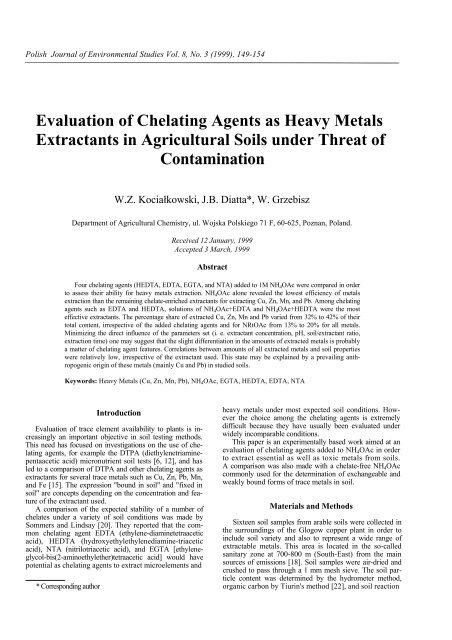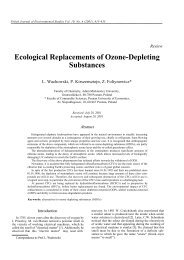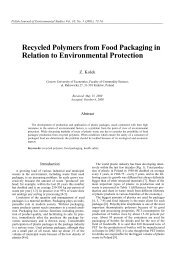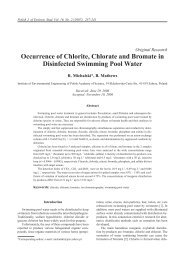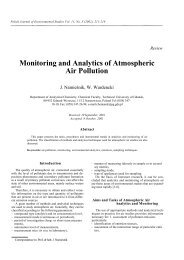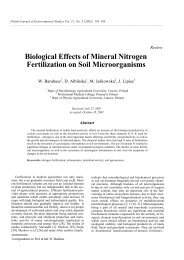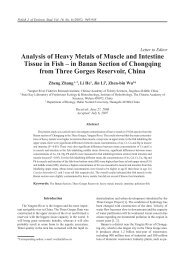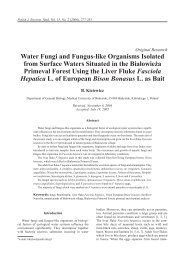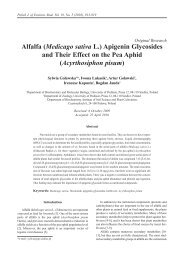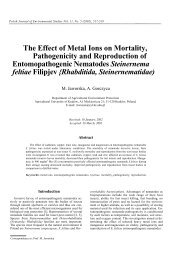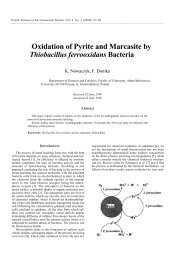Evaluation of Chelating Agents as Heavy Metals Extractants in ...
Evaluation of Chelating Agents as Heavy Metals Extractants in ...
Evaluation of Chelating Agents as Heavy Metals Extractants in ...
Create successful ePaper yourself
Turn your PDF publications into a flip-book with our unique Google optimized e-Paper software.
Polish Journal <strong>of</strong> Environmental Studies Vol. 8, No. 3 (1999), 149-154<br />
<strong>Evaluation</strong> <strong>of</strong> <strong>Chelat<strong>in</strong>g</strong> <strong>Agents</strong> <strong>as</strong> <strong>Heavy</strong> <strong>Metals</strong><br />
<strong>Extractants</strong> <strong>in</strong> Agricultural Soils under Threat <strong>of</strong><br />
Contam<strong>in</strong>ation<br />
W.Z. Kociałkowski, J.B. Diatta*, W. Grzebisz<br />
Department <strong>of</strong> Agricultural Chemistry, ul. Wojska Polskiego 71 F, 60-625, Poznan, Poland.<br />
Received 12 January, 1999<br />
Accepted 3 March, 1999<br />
Abstract<br />
Four chelat<strong>in</strong>g agents (HEDTA, EDTA, EGTA, and NTA) added to 1M NH 4 OAc were compared <strong>in</strong> order<br />
to <strong>as</strong>sess their ability for heavy metals extraction. NH 4 OAc alone revealed the lowest efficiency <strong>of</strong> metals<br />
extraction than the rema<strong>in</strong><strong>in</strong>g chelate-enriched extractants for extract<strong>in</strong>g Cu, Zn, Mn, and Pb. Among chelat<strong>in</strong>g<br />
agents such <strong>as</strong> EDTA and HEDTA, solutions <strong>of</strong> NH 4 OAc+EDTA and NH 4 OAc+HEDTA were the most<br />
effective extractants. The percentage share <strong>of</strong> extracted Cu, Zn, Mn and Pb varied from 32% to 42% <strong>of</strong> their<br />
total content, irrespective <strong>of</strong> the added chelat<strong>in</strong>g agents and for NRtOAc from 13% to 20% for all metals.<br />
M<strong>in</strong>imiz<strong>in</strong>g the direct <strong>in</strong>fluence <strong>of</strong> the parameters set (i. e. extractant concentration, pH, soil/extractant ratio,<br />
extraction time) one may suggest that the slight differentiation <strong>in</strong> the amounts <strong>of</strong> extracted metals is probably<br />
a matter <strong>of</strong> chelat<strong>in</strong>g agent features. Correlations between amounts <strong>of</strong> all extracted metals and soil properties<br />
were relatively low, irrespective <strong>of</strong> the extractant used. This state may be expla<strong>in</strong>ed by a prevail<strong>in</strong>g anthropogenic<br />
orig<strong>in</strong> <strong>of</strong> these metals (ma<strong>in</strong>ly Cu and Pb) <strong>in</strong> studied soils.<br />
Keywords: <strong>Heavy</strong> <strong>Metals</strong> (Cu, Zn, Mn, Pb), NH 4 OAc, EGTA, HEDTA, EDTA, NTA<br />
Introduction<br />
<strong>Evaluation</strong> <strong>of</strong> trace element availability to plants is <strong>in</strong>cre<strong>as</strong><strong>in</strong>gly<br />
an important objective <strong>in</strong> soil test<strong>in</strong>g methods.<br />
This need h<strong>as</strong> focused on <strong>in</strong>vestigations on the use <strong>of</strong> chelat<strong>in</strong>g<br />
agents, for example the DTPA (diethylenetriam<strong>in</strong>epentaacetic<br />
acid) micronutrient soil tests [6, 12], and h<strong>as</strong><br />
led to a comparison <strong>of</strong> DTPA and other chelat<strong>in</strong>g agents <strong>as</strong><br />
extractants for several trace metals such <strong>as</strong> Cu, Zn, Pb, Mn,<br />
and Fe [15]. The expression "bound <strong>in</strong> soil" and "fixed <strong>in</strong><br />
soil" are concepts depend<strong>in</strong>g on the concentration and feature<br />
<strong>of</strong> the extractant used.<br />
A comparison <strong>of</strong> the expected stability <strong>of</strong> a number <strong>of</strong><br />
chelates under a variety <strong>of</strong> soil conditions w<strong>as</strong> made by<br />
Sommers and L<strong>in</strong>dsay [20]. They reported that the common<br />
chelat<strong>in</strong>g agent EDTA (ethylene-diam<strong>in</strong>etetraacetic<br />
acid), HEDTA (hydroxyethylethylenediam<strong>in</strong>e-triacetic<br />
acid), NTA (nitrilotriacetic acid), and EGTA [ethyleneglycol-bis(2-am<strong>in</strong>oethylether)tetraacetic<br />
acid] would have<br />
potential <strong>as</strong> chelat<strong>in</strong>g agents to extract microelements and<br />
* Correspond<strong>in</strong>g author<br />
heavy metals under most expected soil conditions. However<br />
the choice among the chelat<strong>in</strong>g agents is extremely<br />
difficult because they have usually been evaluated under<br />
widely <strong>in</strong>comparable conditions.<br />
This paper is an experimentally b<strong>as</strong>ed work aimed at an<br />
evaluation <strong>of</strong> chelat<strong>in</strong>g agents added to NH 4 OAc <strong>in</strong> order<br />
to extract essential <strong>as</strong> well <strong>as</strong> toxic metals from soils.<br />
A comparison w<strong>as</strong> also made with a chelate-free NH 4 OAc<br />
commonly used for the determ<strong>in</strong>ation <strong>of</strong> exchangeable and<br />
weakly bound forms <strong>of</strong> trace metals <strong>in</strong> soil.<br />
Materials and Methods<br />
Sixteen soil samples from arable soils were collected <strong>in</strong><br />
the surround<strong>in</strong>gs <strong>of</strong> the Glogow copper plant <strong>in</strong> order to<br />
<strong>in</strong>clude soil variety and also to represent a wide range <strong>of</strong><br />
extractable metals. This area is located <strong>in</strong> the so-called<br />
sanitary zone at 700-800 m (South-E<strong>as</strong>t) from the ma<strong>in</strong><br />
sources <strong>of</strong> emissions [18]. Soil samples were air-dried and<br />
crushed to p<strong>as</strong>s through a 1 mm mesh sieve. The soil particle<br />
content w<strong>as</strong> determ<strong>in</strong>ed by the hydrometer method,<br />
organic carbon by Tiur<strong>in</strong>'s method [22], and soil reaction
150 Kociałkowski W.Z. et al.<br />
(pH) <strong>in</strong> 0.01M CaCl 2 [17] us<strong>in</strong>g a gl<strong>as</strong>s electrode. Cation<br />
exchange capacity (CEC) by the Mehlichg 8.2 method <strong>in</strong> Kociatkowski<br />
and Ratajczak [10] modification. Some soil<br />
physicochemical properties are listed <strong>in</strong> Table 1.<br />
Table 1. Physical and chemical properties <strong>of</strong> the studied soils<br />
( n = 16).<br />
Results and Discussion<br />
<strong>Extractants</strong> were compared accord<strong>in</strong>g to the amount <strong>of</strong><br />
each metal extracted. Despite differences <strong>in</strong> pH, texture,<br />
organic matter content and total extractable metals among<br />
the 16 studied soils, the relative rank<strong>in</strong>g <strong>of</strong> extractants w<strong>as</strong><br />
somewhat variable. Consequently, the results are summarized<br />
on the b<strong>as</strong>is <strong>of</strong> means, medians, and ranges <strong>of</strong> amounts<br />
given <strong>in</strong> Table 3. Expression <strong>in</strong> percentage <strong>of</strong> amounts <strong>of</strong><br />
extracted metals allowed us to set a better estimation <strong>of</strong> the<br />
ability <strong>of</strong> the extractants to extract the <strong>in</strong>vestigated metals.<br />
Table 3. <strong>Evaluation</strong> <strong>of</strong> Cu, Zn, Mn, and Pb extractability by different<br />
chelat<strong>in</strong>g agents and a chelate-free extractant (n = 16).<br />
* CEC - cation exchange capacity<br />
All chelat<strong>in</strong>g agents (EDTA [5] with modification, EG-<br />
TA, HEDTA, and NTA) were prepared to give a concentration<br />
<strong>of</strong> 0.005M <strong>of</strong> a given reagent. They were buffered by<br />
a mixture <strong>of</strong> 1M <strong>of</strong> acetic acid and ammonium acetate.<br />
A chelate-free extractant, i.e. 1M NH 4 OAc (acid ammonium<br />
acetate solution), [11] w<strong>as</strong> also prepared and considered<br />
<strong>as</strong> standard. The f<strong>in</strong>al solution pH <strong>of</strong> all extractants<br />
w<strong>as</strong> carefully adjusted to 4.65 with diluted CH 3 COOH or<br />
NH4OH. Table 2 illustrates some extractant features and<br />
extraction procedures used.<br />
The total metal content w<strong>as</strong> extracted <strong>in</strong> an "Aqua regia"<br />
(A.r.) (HCl/HNO 3 ; 3:1 ratio) concentrated mixture by<br />
heat<strong>in</strong>g 2g <strong>of</strong> soil <strong>in</strong> 30 cm 3 <strong>of</strong> A.r. <strong>Metals</strong> <strong>in</strong> all chelat<strong>in</strong>g<br />
extractants were extracted at the ratios <strong>of</strong> 3 g <strong>in</strong> 15 cm 3 <strong>of</strong><br />
appropriate extractant. The extraction time (shak<strong>in</strong>g) l<strong>as</strong>ted<br />
one hour and after an overnight decantation extracts were<br />
filtered and analyzed for Cu, Zn, Mn and Pb contents by<br />
AAS method (Atomic Absorption Spectrophotometry, Varian<br />
Spectra 250 plus). Statistical estimations and other<br />
computations were made by us<strong>in</strong>g Statgraphics (ANOVA)<br />
procedures.<br />
Table 2. Chemical characteristics <strong>of</strong> extractants used <strong>in</strong> the work.<br />
• The concentration <strong>of</strong> 0.005M w<strong>as</strong> set for all chelat<strong>in</strong>g<br />
agents + NH 4 OAc (+1.0): means 1M NH 4 OAc<br />
• ** Extraction time <strong>in</strong> hours<br />
• *** Soil / Solution ratio
<strong>Evaluation</strong> <strong>of</strong> <strong>Chelat<strong>in</strong>g</strong> ... 151<br />
Extraction <strong>of</strong> Cu<br />
Comparison <strong>of</strong> the results for Cu showed some dispersions<br />
<strong>in</strong> the amounts <strong>of</strong> metals extracted by the chelate-free<br />
NH 4 OAc and with added chelat<strong>in</strong>g agents. Among the chelat<strong>in</strong>g<br />
extractants NT A extracted 33% <strong>of</strong> total Cu content<br />
where<strong>as</strong> an average <strong>of</strong> 40% <strong>of</strong> total Cu w<strong>as</strong> found for<br />
HEDTA, EDTA and EGTA be<strong>in</strong>g attributed to the very<br />
similar pK values <strong>of</strong> these three chelat<strong>in</strong>g agents, [13].<br />
NH 4 OAc w<strong>as</strong> clearly differentiated from other extractants<br />
because it extracted only 17%. These values are graphically<br />
presented <strong>in</strong> Figures 1, 2, 3, 4, and 5. On this b<strong>as</strong>is extractants<br />
may be ranged <strong>as</strong> follows:<br />
HEDTA (42%) > EDTA (40%) ≈ EGTA (39%) ><br />
> NTA (33%) > NH 4 OAc (17%) (1)<br />
Figs. 1, 2, 3, 4, 5: Illustration <strong>of</strong> the percentage share <strong>of</strong> Cu, Zn, Mn, and Pb extracted by HEDTA, EDTA, EGTA, NTA, and NH 4 OAc <strong>in</strong><br />
their total content (Aqua regia - 100%).
152 Kociałkowski W.Z. et al.<br />
<strong>Chelat<strong>in</strong>g</strong> agents are <strong>in</strong>volved <strong>in</strong> metal complexation by<br />
provid<strong>in</strong>g N (nitrogen) and O (oxygen) atoms <strong>as</strong> donors.<br />
The number <strong>of</strong> these atoms may determ<strong>in</strong>e the chelat<strong>in</strong>g<br />
strength, (HEDTA: 2 N and 4 O - stronger chelation and<br />
NTA: 1 N and 3 O - weaker chelation). The results suggest<br />
that, <strong>in</strong> most <strong>in</strong>vestigated soils, the chelation <strong>of</strong> Cu w<strong>as</strong><br />
sufficient to remove all that could be rele<strong>as</strong>ed simply by<br />
decre<strong>as</strong><strong>in</strong>g the activity <strong>of</strong> Cu 2+ . A similar c<strong>as</strong>e w<strong>as</strong> reported<br />
by Norvell [15], who stated that <strong>in</strong> some Cu-contam<strong>in</strong>ated<br />
soils, the rele<strong>as</strong>e <strong>of</strong> Cu appeared to be related to differences<br />
<strong>in</strong> the stability <strong>of</strong> the Cu chelate formed. This discrepancy<br />
may be a pro<strong>of</strong> <strong>of</strong> different forms <strong>of</strong> soil Cu <strong>in</strong> metal-free<br />
and/or metal-contam<strong>in</strong>ated soils. Copper is reported to present<br />
a high aff<strong>in</strong>ity towards soil organic substances conta<strong>in</strong><strong>in</strong>g<br />
N and O <strong>as</strong> donors [8, 16]. Then <strong>in</strong> organic matter<br />
relatively rich soils the use <strong>of</strong> ammonium acetate for <strong>as</strong>sess<strong>in</strong>g<br />
even exchangeable forms <strong>of</strong> Cu may lead to an underestimation<br />
<strong>of</strong> the amounts <strong>of</strong> Cu be<strong>in</strong>g extracted. Correlations<br />
among the amounts <strong>of</strong> extracted Cu for chelat<strong>in</strong>g<br />
agents were excellent, (r > 0.96, P < 0.05). Only EGTA<br />
showed a high relationship with NH 4 OAc (R 2 = 0.94), <strong>as</strong><br />
illustrated <strong>in</strong> Fig. 6. None <strong>of</strong> the extractants strongly correlated<br />
with soil physicochemical properties (except for<br />
HEDTA), but the value <strong>of</strong> the coefficient <strong>of</strong> determ<strong>in</strong>ation<br />
w<strong>as</strong> low:<br />
Cu-HEDTA = 66.3 - 14.0 pH - 4.2 CEC + 5.8 Corg -<br />
- 0.11 Clay, R 2 = 0.23 (P < 0.05) (2)<br />
Extraction <strong>of</strong> Zn<br />
Extractable Zn <strong>of</strong> the 16 soils varied slightly (about<br />
15.0 mg Zn/kg) between chelat<strong>in</strong>g agents. Notably less Zn<br />
w<strong>as</strong> extracted by NH 4 OAc <strong>in</strong>dicat<strong>in</strong>g its relative <strong>in</strong>effectiveness<br />
(Table 3). HEDTA, EDTA, NTA, and EGTA extracted<br />
on average 33% <strong>of</strong> total Zn, where<strong>as</strong> NH 4 OAc alone<br />
extracted 14% (Figures 1, 2, 3, 4, 5). Apparently, each <strong>of</strong><br />
these chelat<strong>in</strong>g agents chelated Zn well enough to extract<br />
all the Zn that could be <strong>in</strong> soil solution or <strong>in</strong> exchangeable<br />
forms. Some reports have focussed on the moderate ability<br />
<strong>of</strong> Zn to be bound strongly <strong>in</strong> soil lead<strong>in</strong>g to a possible high<br />
Zn extractability [3, 14]. Furthermore, it is worth not<strong>in</strong>g that<br />
Zn levels <strong>in</strong> the soil samples are not high, so weakly-bound<br />
forms will be <strong>in</strong>sufficient. This could be more or less<br />
expected s<strong>in</strong>ce the amounts <strong>of</strong> Zn extracted by NH 4 OAC<br />
rema<strong>in</strong>ed very low. Among all extractants (<strong>in</strong>clud<strong>in</strong>g the<br />
chelate-free one) only the amounts <strong>of</strong> Zn extracted by<br />
NTA showed the highest correlations with all soil<br />
physicochemical properties:<br />
Zn-NTA = 16.4 - 3.1 pH + 0.7 CEC - 0.1 Corg + 0.03 Clay,<br />
R 2 = 0.71 (PNH 4 OAc (14%) (4)
<strong>Evaluation</strong> <strong>of</strong> <strong>Chelat<strong>in</strong>g</strong> ... 153<br />
Extraction <strong>of</strong> Mn<br />
<strong>Chelat<strong>in</strong>g</strong> agents extracted almost similar amounts <strong>of</strong><br />
Mn (about 106.0 mg Mn/kg) represent<strong>in</strong>g only 34% <strong>of</strong> total<br />
soil Mn. In the c<strong>as</strong>e <strong>of</strong> NH 4 OAc this share averaged 20%,<br />
(Table 3 and Figs. 1, 2, 3, 4, 5). Soils used <strong>in</strong> the present<br />
work were almost neutral to moderately b<strong>as</strong>ic (except one<br />
with pH 4.9). This could partly expla<strong>in</strong> the lower efficiency<br />
<strong>of</strong> all extractants for Mn extraction, s<strong>in</strong>ce this metal e<strong>as</strong>ily<br />
forms hydroxides even at moderately neutral soil reaction<br />
[9]. It is also important to po<strong>in</strong>t out the pK values <strong>of</strong> some<br />
<strong>of</strong> these chelat<strong>in</strong>g agents (HEDTA, pK = 11.4; EGTA, pK<br />
= 13.88). The slight differences, ma<strong>in</strong>ly for extractants with<br />
chelat<strong>in</strong>g agents, may suggest that amounts <strong>of</strong> Mn reflect<br />
the e<strong>as</strong>e with which Mn is rele<strong>as</strong>ed from soils. Figure 8 illustrates<br />
only the relationship between EDTA and NH 4 OAc<br />
s<strong>in</strong>ce the rema<strong>in</strong><strong>in</strong>g chelat<strong>in</strong>g agents gave lower values <strong>of</strong><br />
the coefficient <strong>of</strong> determ<strong>in</strong>ation (R 2 < 0.70). Neither ED-<br />
TA, EGTA, NTA nor NH 4 OAc satisfactorily correlated<br />
with soil properties. The multiple regression analysis showed<br />
a relatively high <strong>in</strong>fluence <strong>of</strong> the latter ones on Mn<br />
extraction by HEDTA:<br />
Mn-HEDTA = 92.0 - 17 pH + 3.7 CEC - 0.4 Corg +<br />
+ 0.22 Clay, R 2 = 0.85 (P < 0.05) (5)<br />
On the b<strong>as</strong>is <strong>of</strong> the percentage share, extractants may be<br />
ranged <strong>as</strong> follows:<br />
EDTA (35%) = EGTA (35%) = NTA (35%) ≈<br />
HEDTA (34%) > NH 4 OAc (20%) (6)<br />
Extraction <strong>of</strong> Pb<br />
Lead <strong>in</strong> comparison with Cu, Zn and Mn is considered<br />
a naturally toxic metal. EDTA, HEDTA, and NTA extracted<br />
on average 19.0 mg Pb/kg; EGTA w<strong>as</strong> about 16.5 mg<br />
Pb/kg. As could be expected the lowest Pb level (7.0<br />
mg/kg) w<strong>as</strong> found for NH 4 OAc. In this work it w<strong>as</strong> <strong>in</strong>cluded<br />
<strong>in</strong> order to make a general evaluation <strong>in</strong> terms <strong>of</strong> its<br />
physicochemical characteristics <strong>as</strong> a metal. As listed <strong>in</strong> Table<br />
3, one may observe the follow<strong>in</strong>g percentage range <strong>of</strong><br />
chelat<strong>in</strong>g agent ability for Pb extraction.<br />
EDTA (39.5%) = HEDTA (39%) > NTA (35%) ><br />
> EGTA (31%) > NH 4 OAc (13%) (7)<br />
In terms <strong>of</strong> ability for Pb extraction, EDTA and HED-<br />
TA were found to be the most efficient (about 39% <strong>of</strong> total<br />
Pb), where<strong>as</strong> NH 4 OAc (13%) w<strong>as</strong> less so, (Table 3 and<br />
Figs. 1, 2, 3, 4, 5). Our results showed that these two<br />
chelate-enriched extractants can be permutated satisfactorily.<br />
Amounts <strong>of</strong> Pb extracted by all chelat<strong>in</strong>g agents were<br />
among them highly correlated (r > 0.90, P < 0.05). But <strong>in</strong><br />
the c<strong>as</strong>e <strong>of</strong> their relationship with the chelate-free extractant<br />
only HEDTA-NH 4 OAc gave a coefficient <strong>of</strong> determ<strong>in</strong>ation<br />
R 2 > 0.95 (Fig. 9). Amounts <strong>of</strong> Pb extracted were<br />
poorly correlated with soil physicochemical properties, irrespective<br />
<strong>of</strong> the type <strong>of</strong> extractant. A similar c<strong>as</strong>e w<strong>as</strong><br />
reported by Diatta et al. [4], who found a poor relationship<br />
between Pb extracted by HCl and HNO 3 and physicochemical<br />
properties. The multiple regression analysis established<br />
for EDTA gave the best fit, <strong>as</strong> shown below:<br />
Pb-EDTA = 95.0 - 15.0 pH - 2.0 CEC + 2. 08 Corg +<br />
+ 0.05 Clay, R 2 = 0.67 (P < 0.05) (8)<br />
Extraction methods are ma<strong>in</strong>ly b<strong>as</strong>ed on the ratio <strong>of</strong><br />
a given reagent (extractant) to a given weight <strong>of</strong> soil sample,<br />
and on the chemical feature <strong>of</strong> the extractant, i. e. with or<br />
without chelat<strong>in</strong>g agent. Some extractants commonly<br />
extract a wide range <strong>of</strong> soil elements while others are applied<br />
for a s<strong>in</strong>gle element (fosfonic complexones).<br />
Such possibilities have been earlier presented by Combs<br />
et al. [2] for extraction <strong>of</strong> Cd, Cu, and Zn (at different<br />
soil/solution). Baron [1] with ammonium acetate (20 g)<br />
+ ammonium sulphate (66 g) + acetic acid (62.5 g) + water<br />
up to 1000ml (pH 4.0) extracted B, Fe, Co, Cu, Mn, Mo<br />
and Zn (at soil/solution <strong>of</strong> 1:25). <strong>Chelat<strong>in</strong>g</strong> agents were<br />
widely applied by Norvell [15] to extract Al, Cu, Ni, Fe,<br />
Zn, Mn (at soil/extractant <strong>of</strong> 1:5).<br />
On the other hand extractions were performed for s<strong>in</strong>gle<br />
elements <strong>as</strong> well. For example Stewart and Berger [21]<br />
used 2N MgCl 2 (at soil/extractant <strong>of</strong> 1:5) to extract only<br />
Zn. In the c<strong>as</strong>e <strong>of</strong> Cu a 0.43N HN0 3 w<strong>as</strong> applied by Henkens<br />
[7] and a chelat<strong>in</strong>g agent (0.05N EDTA + NH 4 Ac; pH<br />
7.0) w<strong>as</strong> <strong>in</strong>troduced by Viro [24] both (at soil/extractant <strong>of</strong><br />
15:25) for Cu extraction.<br />
Summary<br />
On the b<strong>as</strong>is <strong>of</strong> the views presented, one h<strong>as</strong> to take <strong>in</strong>to<br />
account the fact that extraction methods vary depend<strong>in</strong>g on<br />
the conditions and aim. All these methods are partly experimental.<br />
Our results showed the importance a comparison<br />
<strong>of</strong> chelat<strong>in</strong>g agents on at le<strong>as</strong>t three parameters (i. e.:<br />
extractant concentration, pH, soil/extractant ratio, extraction<br />
time). The availability to plants <strong>of</strong> soil elements is<br />
ruled by several natural factors such <strong>as</strong> soil reaction, soil<br />
physicochemical properties, temperature, and climate. Furthermore,<br />
one chelat<strong>in</strong>g agent feature is the possibility to<br />
chelate metals <strong>in</strong> solution, avoid<strong>in</strong>g metal resorption by soil<br />
organo-m<strong>in</strong>eral particles. Another advantage <strong>of</strong> chelates<br />
over most and neutral salts is that the pH <strong>of</strong> the extract<strong>in</strong>g<br />
medium can be ma<strong>in</strong>ta<strong>in</strong>ed more closely to the normal pH<br />
<strong>of</strong> soils. Undesirable side reactions can be avoided and the<br />
extraction procedures can be made more selective for specific<br />
elements us<strong>in</strong>g complexones [19, 23]. Results <strong>of</strong> this<br />
<strong>in</strong>vestigation present a practical approach and may help<br />
somewhat <strong>in</strong> choos<strong>in</strong>g a chelat<strong>in</strong>g agent for the extraction<br />
<strong>of</strong> a given metal or group <strong>of</strong> metals. Furthermore the fractions<br />
<strong>of</strong> metals be<strong>in</strong>g extracted may be <strong>as</strong>signed <strong>as</strong> "potentially"<br />
plant available.<br />
Conclusions<br />
1. The amounts <strong>of</strong> Cu, Zn, Mn and Pb extracted by<br />
chelat<strong>in</strong>g agents were not so notably differentiated among<br />
the respective extractants.<br />
2. The percentage share <strong>of</strong> extracted Cu, Zn, Mn and Pb<br />
varied from 32 to 42% <strong>of</strong> their total, irrespective <strong>of</strong> the<br />
chelat<strong>in</strong>g agents and for chelate-free extractant NH 4 OAc<br />
from 13 to 20% for all metals.<br />
3. The best chelat<strong>in</strong>g agent for extraction <strong>of</strong> all metals<br />
w<strong>as</strong> EDTA. Copper and lead were both satisfactorily ex<br />
tracted by HEDTA <strong>as</strong> well <strong>as</strong> EDTA.
154 Kociałkowski W.Z. et al.<br />
4. The amounts <strong>of</strong> all extracted metals may be attributed<br />
more to chelat<strong>in</strong>g agents feature than to the soil/extractant<br />
ratio, extraction time, extractants concentrations, and extractant<br />
pH.<br />
5. Correlations between amounts <strong>of</strong> all extracted metals<br />
and soil properties were relatively low, irrespective <strong>of</strong> the<br />
extractant used. This is due to the prevailance <strong>of</strong> anthropogenically<br />
contam<strong>in</strong>ated soils.<br />
References<br />
1. BARON H. Extraction and chemical determ<strong>in</strong>ation <strong>of</strong> e<strong>as</strong>ily<br />
soluble boron, iron, cobalt, copper, manganese, molybdenum<br />
and z<strong>in</strong>c <strong>in</strong> soil. Landwirtsch. Forsch., 7, 82, 1955.<br />
2. COMBS S. M., DOWDY R. H. DTPA: The effect <strong>of</strong> extrac<br />
tion techniques on Cu, Cd, Ni and Zn extraction from dredged<br />
materials and correlations with plant metal uptake. Comm. <strong>in</strong><br />
Soil Sci. Plant Anal. 13 (2), 87, 1982.<br />
3. DIATTA J., KOCIALKOWSKI W. Adsorption <strong>of</strong> z<strong>in</strong>c <strong>in</strong> so<br />
me selected soils. Pol. Jour. Envir. Studies, Vol. 7 (4), 195,<br />
1998<br />
4. DIATTA J. B., GRZEBISZ W., POTARZYCKI J. The suita<br />
bility <strong>of</strong> 1M HC1 and 2M HNO 3 for heavy metals extraction <strong>in</strong><br />
arable soils under threat <strong>of</strong> contam<strong>in</strong>ation. Rocz. AR Poznan,<br />
CCXCIV(l), 31-38,1997.<br />
5. GUPTA S. K. HAENI H H. Methodik zur Bestimung biologisch<br />
relevanter Schwermetallkonzentrationen im Boden<br />
und Uberprufung der Auswirkungen auf Tespflanzen sowie<br />
Mikroorganismen <strong>in</strong> bel<strong>as</strong>teten Gebieten. FAC Liebefeld.<br />
Schweiz, 1989.<br />
6. HAYNES R J., SWIFT R.S. An evaluation <strong>of</strong> the use <strong>of</strong><br />
DTPA and EDTA <strong>as</strong> extractants for micronutrients <strong>in</strong> modera<br />
tely acid soils. Plant and Soil 74, 111, 1983.<br />
7. HENKENS C. H. Bemest<strong>in</strong>g sbeleid ten aanzien van storenelementen.<br />
Lanbouwk. Tijdschr. 16, 691, 1962.<br />
8. JARVIS S.C. Copper sorption by soil at low concentrations<br />
and relation to upatake by plant. Journal <strong>of</strong> Soil Science, 32,<br />
257, 1981.<br />
9. KABATA-PENDIAS A. Behaviournal properties <strong>of</strong> trace me<br />
tals <strong>in</strong> soil. Applied Geochemistry, Suppl. Issue (2), pp 3-9,<br />
1993.<br />
10. KOCIALKOWSKI W.Z., RATAJCZAK M. J. A modified<br />
method for exchangeable cations and cation exchange capaci-<br />
ty determ<strong>in</strong>ation is soil accord<strong>in</strong>g to Mehlich. Rocz. AR Poznan;<br />
CXLVI, 106, 1984 (<strong>in</strong> polish).<br />
11. LAKANEN E. The effect <strong>of</strong> lim<strong>in</strong>g on the adsorption and<br />
exchange characteristics <strong>of</strong> trace elements <strong>in</strong> soils. Acta Agric.<br />
Scand. 17, 131, 1967.<br />
12. LINDSAY W. L., NORVELL W. A. Development <strong>of</strong> a DTPA<br />
soil test for z<strong>in</strong>c, iron, manganese and copper. Soil Sci. Soc.<br />
Am. J., 42, 421, 1978.<br />
13. MARTEL A.E., SMITH R. M. Critical stability constants.<br />
Vol. 6, Plenum New York, 1989.<br />
14. NIELSEN D.J. Specific z<strong>in</strong>c adsorption <strong>as</strong> related to the com<br />
position and properties <strong>of</strong> clay and silt <strong>in</strong> some Danish soils.<br />
Acta Agric. Scand. 40, 3, 1990.<br />
15. NORVELL W.A. Comparison <strong>of</strong> chelat<strong>in</strong>g agents <strong>as</strong> extrac<br />
tants for metals <strong>in</strong> diverse soil materials. Soil Sci. Soc. Am. J.<br />
48, 1285, 1984.<br />
16. OKAZAKI M., TAKAMIDOH K., YAMANE I. Adsorption<br />
<strong>of</strong> heavy metal cations on hydrated oxides and oxides <strong>of</strong> iron<br />
and alum<strong>in</strong>ium with different crystall<strong>in</strong>ities. Soil Sci. Plant<br />
Nutr., 32 (4), 523, 1986.<br />
17. Polska Norma: Polski Komitet Normalizacyjny, nr ref.<br />
PrPN-ISO 10390 (E), Jakosc gleby i oznaczanie pH. Pierwsze<br />
wydanie 1994.<br />
18. RACHWAL L., SIENKIEWICZ A., KOMISAREK J., KO<br />
CIALKOWSKI W. Rozmieszczenie na r6znych glebokosciach<br />
oraz frakcjonowanie Cu, Pb i Zn w glebach strefy ochronnej<br />
Hut Miedzi w Glogowie. PTPN, Tom LXIX, str. 101-114,<br />
1990.<br />
19. SIEPAK J. Wl<strong>as</strong>ciwosci i z<strong>as</strong>tosowania w chemii analitycznej<br />
nowych kompleksonow fosforoorganicznych. Praca habilitacyjna,<br />
Seria Chemia nr 53, UAM, 1998.<br />
20. SOMMERS L.E., LINDSAY W.L. Effect <strong>of</strong> pH and redox on<br />
predicted heavy metal-chelate equilibria <strong>in</strong> soils. Soil Sci. Soc.<br />
Am. J. 43, 39, 1979.<br />
21. STEWART J.A., BECGER K.C. Estimation <strong>of</strong> available soil<br />
z<strong>in</strong>c us<strong>in</strong>g magnesium chloride <strong>as</strong> extractant. Soil Sci., 100,<br />
244, 1965.<br />
22. TIURIN N.W. K metodikie analiza dla sprawnitielnogo izuczenija<br />
sostawa poczwiennogo pieregnoja ili gumusa. Rabota<br />
po organiczeskomu wieszczestwu poczwy. Moskwa 1951.<br />
23. VIETS F.G., L<strong>in</strong>dsay W.L. Test<strong>in</strong>g soils for z<strong>in</strong>c, copper man<br />
ganese, and iron. Repr<strong>in</strong>t from Soil Test<strong>in</strong>g and Plant Analy<br />
sis; Rev. Edition, Madison, Vis. 53711, pp. 153-170, 1973.<br />
24. VIRO P.J. Utilization <strong>of</strong> EDTA <strong>in</strong> soils analysis. Soil Sci., 79,<br />
459, 1955.


